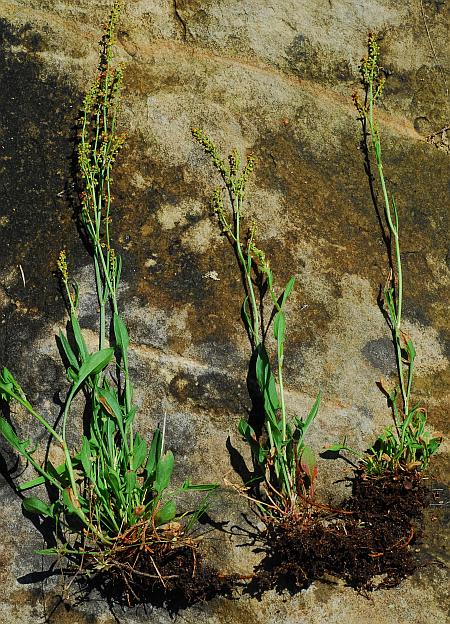Rumex acetosella L.
Sheep Sorrel

Introduced
CC = *
CW = 3
MOC = 68
© SRTurner
Rumex acetosella L.Sheep Sorrel | |
 |
Introduced CC = * CW = 3 MOC = 68 |
© SRTurner |
|
Family - Polygonaceae Habit - Perennial forb, dioecious, with slender, often long-creeping rhizomes. Stems - Ascending to erect, to 40 cm, often multiple from base, usually unbranched below the inflorescence, thin, angled, ridged, glabrous. Leaves alternate and basal, the basal rosette well developed at flowering. Ocreae membranous to papery, becoming irregularly dissected above the midpoint at maturity, light brown to reddish brown toward the base, grading to white or pale and translucent toward the tip.
Leaves - Basal leaves mostly long-petiolate, the blade similar to those of the lower stem leaves. Blades of stem leaves 2-6 cm long 0.3-2.0 cm wide, thin and herbaceous to slightly succulent, narrowly ovate to lanceolate-elliptic, lanceolate, or oblong-obovate, usually with a pair of spreading, bluntly triangular basal lobes, the margins otherwise entire, flat or nearly so, truncate to slightly concave at the base, angled or tapered to a bluntly or sharply pointed tip, rarely rounded at the tip, the surfaces glabrous. Upper stem leaves reduced, usually lacking lobes.
Inflorescence - Terminal paniculate arrangement of racemes to 20 cm tall, usually occupying the upper 1/2-2/3 of the plant, the main axis usually somewhat zigzag, occasionally reclining, interrupted. Flowers 5-8 per whorled fascicle, the stalks 1-3 mm, about as long as to about 2 times as long as the fruiting perianth, arched downward or drooping at maturity, not jointed.
Flowers - Staminate flowers with 6 tepals in two whorls, these to 1 mm long, 0.5 mm broad, acute to rounded at apex, scarious, spreading with maturity. Stamens 6. Filaments to 0.5mm long, glabrous, yellowish. Anthers to 1 mm long, yellow. Pistillate flowers with the tepals not or only slightly enlarged at fruiting, 1.2-1.7 mm long, 0.5-1.3 mm wide, green, not developing noticeable wings or nerves at fruiting, angled at the base, bluntly to more or less sharply pointed at the tip, the margins entire, the surfaces not strongly nerved; tubercles absent; outer whorl of tepals ascending at fruiting.
Fruits - Achenes 0.9-1.5 mm long, 0.6-0.9 mm wide, brown to dark brown.
Flowering - May - September. Habitat - Pond margins, upland prairies, glades, ledges and tops of bluffs, pastures, fields, railroads, roadsides, open disturbed areas; usually on acidic substrates. Origin - Native to Europe. Lookalikes - R. hastatulus. Other info. - This inconspicuous little plant is considered to belong to a different subgenus than the other species of Rumex in Missouri by virtue of its dioecious reproductive habit. Thus it is commonly referred to as a sorrel rather than a dock. It is found throughout Missouri and the continental U.S., though somewhat uncommon in the Plains states. It can be a noxious weed under certain conditions, such as in the acidic soils common to blueberry farms. Photographs taken at Dave Rock Conservation Area, St. Claire County, MO., 7-27-00 and in Brown Summit, NC., 4-20-03 (DETenaglia); also at Sand Prairie Conservation Area, Scott County, MO, 6-17-2013, and LaBarque Creek Conservation Area, Jefferson County, MO, 5-9-2017 (SRTurner). |